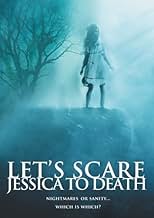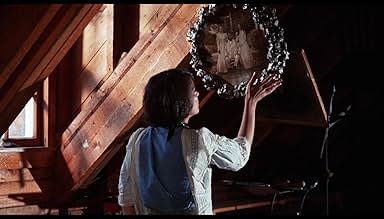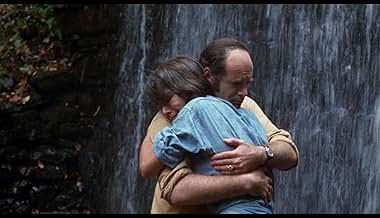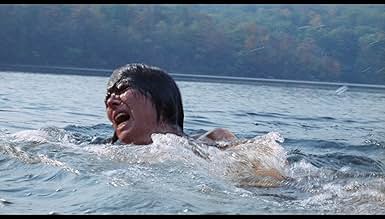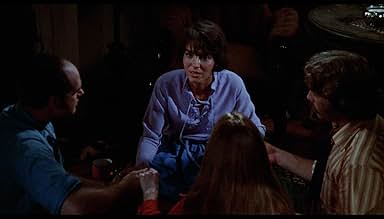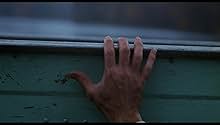NOTE IMDb
6,4/10
9,9 k
MA NOTE
Ajouter une intrigue dans votre langueA recently institutionalized woman has bizarre experiences after moving into a supposedly haunted country farmhouse and fears she may be losing her sanity once again.A recently institutionalized woman has bizarre experiences after moving into a supposedly haunted country farmhouse and fears she may be losing her sanity once again.A recently institutionalized woman has bizarre experiences after moving into a supposedly haunted country farmhouse and fears she may be losing her sanity once again.
- Réalisation
- Scénario
- Casting principal
Avis à la une
No need to repeat the plot. Despite a catch-penny title and a no-name origin, this is a spellbinding horror film. It's also a work of considerable subtlety that doesn't tip its hand in obvious ways. I can see why many dislike the results—the title promises one thing, whereas the results amount to something else. Then too, it's slowly paced, depending more on mood and morbid interest than the more familiar mayhem and gore. Nonetheless, the overall effect tends to be cumulative, such that once you're drawn in, you can't let go. And judging from the number of comments on the Message Board, it's a seductive film, indeed.
Making the main character (Lampert) a recovering mental patient places an overriding ambiguity at the story's center—how many of her creepy experiences are real and how many are imagined. My take is that most are real, whereas the whispers are imagined. But no interpretation, I believe, can be conclusive, which is how it should be for a film like this.
To me psychological horror is much more effective than the palpable kind, since imagination is scarier than obvious blood and gore. The reviewer who likens mood and predicament here to Bergman's highbrow Hour of the Wolf (1968) makes an apt comparison despite the difference in pedigree. There's also a lot of 1940's horror-meister Val Lewton here, as well.
It's hard to say enough about Lampert's beguiling performance. It's also one reason the film's so seductive. I'm just sorry she didn't have more of the headline career her talent deserves. Anyway, the movie came as a happy surprise. Because I was fooled by the exploitative title, I did have to watch it a second time in order to try to put the various threads together. Despite the budgetary lapses, the movie can hold its own with such atmospheric classics as The Other (1972) and Don't Look Now (1973). So don't miss it, unless you want things spelled out in tidy fashion.
Making the main character (Lampert) a recovering mental patient places an overriding ambiguity at the story's center—how many of her creepy experiences are real and how many are imagined. My take is that most are real, whereas the whispers are imagined. But no interpretation, I believe, can be conclusive, which is how it should be for a film like this.
To me psychological horror is much more effective than the palpable kind, since imagination is scarier than obvious blood and gore. The reviewer who likens mood and predicament here to Bergman's highbrow Hour of the Wolf (1968) makes an apt comparison despite the difference in pedigree. There's also a lot of 1940's horror-meister Val Lewton here, as well.
It's hard to say enough about Lampert's beguiling performance. It's also one reason the film's so seductive. I'm just sorry she didn't have more of the headline career her talent deserves. Anyway, the movie came as a happy surprise. Because I was fooled by the exploitative title, I did have to watch it a second time in order to try to put the various threads together. Despite the budgetary lapses, the movie can hold its own with such atmospheric classics as The Other (1972) and Don't Look Now (1973). So don't miss it, unless you want things spelled out in tidy fashion.
Jessica (Zohra Lampert) is a troubled woman. Recently "cured" of a psychological disorder, she and her husband, along with a friend, move to a large house in the country. Upon arriving, they find a mysterious, but agreeable woman named Emily (Mariclare Costello) living in their house. They invite her to stay and things seem to be going smoothly. But Jessica has started having visions again. She sees people who aren't there, hears voices, and discovers dead bodies. No one else notices anything. Is Jessica going mad? Or is there something more evil going on?
For the most part, Let's Scare Jessica to Death works as a slow-moving, atmospheric horror film. If you need chainsaws rumbling, masked killers, and blood spurting, steer clear of this one. But if you're a fan of slow-burn, subtle horror, you will find a lot to enjoy. There are moments in Let's Scare Jessica to Death that go beyond creepy and enter the realm of downright scary. The film has the feel to it of something just under the surface you can't see, but scares you nonetheless. Images like Emily coming out of the water in her wedding dress are classic. And, overall the film looks great - and by great I mean suitably dark and foreboding. The acting is generally good with Costello giving a standout performance. A lot has been written about Lampert - some going so far as to call her performance "Oscar Worthy". To me, she seems to be trying a bit too hard. Yeah, we know she's a nutcase, but that doesn't excuse some of the over-the-top histrionics. Get over yourself!
Notice I wrote that Let's Scare Jessica to Death works "for the most part". I have never cared for the ending. The finale takes the film in a completely different direction from anything that comes before. For lack of a better word, it's too obvious. It's as if someone demanded something more overt in the ending. A more subtle, mysterious ending would have fit better with the atmospheric feeling that the film had been building. Instead, we're given an ending that really harms what is otherwise a classic horror film.
For the most part, Let's Scare Jessica to Death works as a slow-moving, atmospheric horror film. If you need chainsaws rumbling, masked killers, and blood spurting, steer clear of this one. But if you're a fan of slow-burn, subtle horror, you will find a lot to enjoy. There are moments in Let's Scare Jessica to Death that go beyond creepy and enter the realm of downright scary. The film has the feel to it of something just under the surface you can't see, but scares you nonetheless. Images like Emily coming out of the water in her wedding dress are classic. And, overall the film looks great - and by great I mean suitably dark and foreboding. The acting is generally good with Costello giving a standout performance. A lot has been written about Lampert - some going so far as to call her performance "Oscar Worthy". To me, she seems to be trying a bit too hard. Yeah, we know she's a nutcase, but that doesn't excuse some of the over-the-top histrionics. Get over yourself!
Notice I wrote that Let's Scare Jessica to Death works "for the most part". I have never cared for the ending. The finale takes the film in a completely different direction from anything that comes before. For lack of a better word, it's too obvious. It's as if someone demanded something more overt in the ending. A more subtle, mysterious ending would have fit better with the atmospheric feeling that the film had been building. Instead, we're given an ending that really harms what is otherwise a classic horror film.
I wouldn't expect such a luridly titled horror film to be as multi-layered as LET'S SCARE JESSICA TO DEATH is. JESSICA is first and foremost a psychological drama of rural paranoia but the marginal use of the living dead in the final act (or at least a vague version of them left unexplained by the film) is worth noting for one reason: the 'living dead' films (and I use the term very loosely here) that followed in NIGHT OF THE LIVING DEAD's wake in the early 70's were a lot more interesting and innovative (even if the executions often left a lot to be desired) than the typical "zombie" flicks that followed DAWN OF THE DEAD and more or less solidified what a 'zombie flick' is supposed to be.
What distinguishes the two eras is the bitter aftertaste of the hippie dream gone bad, the chemical hangover of the age of Aquarius crushed under the weight of its own hopes, one tab of LSD at a time. The titular heroine in JESSICA is taken to a remote countryhouse by her musician husband and his friend, to recover from a psychotic episode she suffered six months ago in New York. On arriving in the small village, they are greeted with hostility by the creepy old men that inhabit it ("damned hippies!"), and discover a young girl living in the house. They invite her to stay with them for a while but she quickly becomes romantically entangled with both men, while Jessica spends her time trying to hold onto her sanity which is not helped by apparitions of a girl in a white gown.
JESSICA at its heart is a moving psychodrama about a woman trying to hold onto her sanity as the world around her bears her false witness. When Jessica discovers the young girl living in the house but still needs her husband's confirmation that the girl is real and not a figment of her imagination ("it's okay, I saw it too Jess") we realize she's "broken before a frozen god" (to use Cormac McCarthy's words).
But even in 90 minutes running time, relatively unknown director John Hancock finds place in his movie for commentaries on small-town hostility, extra-marital drama, post-hippy broken dreams (the two men and Jessica arrive in the small time driving a hearse with the peace symbol stenciled on the side) and an intriguing mix of ambiguous supernatural horror and psychological drama that recalls some of the best moments of the genre, from THE HAUNTING to the works of Jacques Tourneur in the 40's. As Jessica mutters to herself in one of the many monologues delivered with a close-miked intimacy that almost makes us voyers of her psyche: "Madness and sanity, dreams and reality. I don't know which is which." If there are plot inconsistencies and threads unresolved (not least of all the white-gowned girl - which was added on the script on demand by the producers), they are overshadowed by the mesmerizing effect of the entire movie. Pivotal in the film is Zohra Lampert's stunning performance as Jessica, carrying with her the fragile air of a person who is trying to pass for normal but also a genuine love for life. As with Robert Altman's heroines in his psychodrama 3 WOMEN, Hancock has only sympathy for Jessica's drama. To quote Stephen Thrower, "Jessica walks with the gauche fragility of a doll hoping to pass for human; her movements are cautious re-enactments of grace, an approach well suited to the role of an intelligent, sensitive woman recovering from a nervous breakdown". It is truly an Oscar-worthy tour-de-force and definitely far and above the acting usually associated with low-budget horror films.
What distinguishes the two eras is the bitter aftertaste of the hippie dream gone bad, the chemical hangover of the age of Aquarius crushed under the weight of its own hopes, one tab of LSD at a time. The titular heroine in JESSICA is taken to a remote countryhouse by her musician husband and his friend, to recover from a psychotic episode she suffered six months ago in New York. On arriving in the small village, they are greeted with hostility by the creepy old men that inhabit it ("damned hippies!"), and discover a young girl living in the house. They invite her to stay with them for a while but she quickly becomes romantically entangled with both men, while Jessica spends her time trying to hold onto her sanity which is not helped by apparitions of a girl in a white gown.
JESSICA at its heart is a moving psychodrama about a woman trying to hold onto her sanity as the world around her bears her false witness. When Jessica discovers the young girl living in the house but still needs her husband's confirmation that the girl is real and not a figment of her imagination ("it's okay, I saw it too Jess") we realize she's "broken before a frozen god" (to use Cormac McCarthy's words).
But even in 90 minutes running time, relatively unknown director John Hancock finds place in his movie for commentaries on small-town hostility, extra-marital drama, post-hippy broken dreams (the two men and Jessica arrive in the small time driving a hearse with the peace symbol stenciled on the side) and an intriguing mix of ambiguous supernatural horror and psychological drama that recalls some of the best moments of the genre, from THE HAUNTING to the works of Jacques Tourneur in the 40's. As Jessica mutters to herself in one of the many monologues delivered with a close-miked intimacy that almost makes us voyers of her psyche: "Madness and sanity, dreams and reality. I don't know which is which." If there are plot inconsistencies and threads unresolved (not least of all the white-gowned girl - which was added on the script on demand by the producers), they are overshadowed by the mesmerizing effect of the entire movie. Pivotal in the film is Zohra Lampert's stunning performance as Jessica, carrying with her the fragile air of a person who is trying to pass for normal but also a genuine love for life. As with Robert Altman's heroines in his psychodrama 3 WOMEN, Hancock has only sympathy for Jessica's drama. To quote Stephen Thrower, "Jessica walks with the gauche fragility of a doll hoping to pass for human; her movements are cautious re-enactments of grace, an approach well suited to the role of an intelligent, sensitive woman recovering from a nervous breakdown". It is truly an Oscar-worthy tour-de-force and definitely far and above the acting usually associated with low-budget horror films.
A intelligent depiction of a woman who knows that she may be schizophrenic, but has only her own perceptions upon which to rely, and perceives herself to be increasingly surrounded by the undead. While a bigger budget and today's technology might make this film more effective, and those who didn't endure or enjoy the period in which it was made will find it especially difficult to relate to the characters, this is a very fine film, and should be a source of continued pride for those involved in its making.
I first saw this movie as a somewhat hacked up, scratchy, blotchy, variably-colored, crapophonic late movie on a then-independent station (now a FOX affiliate) when I was a teenager in the '80s, and that is still how I remember it. Even the gorgeous print available on home video doesn't dull "Jessica"'s ability to make you feel really uneasy.
Make no mistake, horror fans brought up on Freddy and Jason are going to think this is supremely lame. There are no wisecracking psychos, unless you count Mariclare Costello's mildly swaggery hippie-vampire Emily, and there is very little in the way of gore, no nudity to speak of, hardly any profanity, and no ass-kicking. It's SLOW. So what gives?
I'll tell you what gives. This movie is SCARY. Not gross, but scary. I can't put my finger on it exactly, but there is a thread that runs under everything that put you slightly off balance and makes you feel icky inside, something that makes even broad daylight seem deathly black and menacing. Credit Bob Baldwin with some nicely atmospheric photography. I'll say this much: a lot of it is in the sound. From the constant wind to the creaks in the farmhouse, from the plaintive minor-key acoustic guitar plucking to the WONDERFUL, unsettling electronic noises by synthesizer pioneer Walter Sear-one of my absolute favorite aspects of this movie-what you hear is almost as important as what you see (or don't see, in this case). The rough edges caused by a miniscule budget make for plenty of continuity errors for the movie buffs to catch, but also somehow make it all seem that much more real.
You keep waiting to be impressed with the slick Tom Savini or Rob Bottin special effects and there are none, you could be watching a documentary road-movie-gone-amuck the way "Jessica" is shot.
And what about Jessica herself? As played by Zohra Lampert, who I believe was primarily known as a comedic actress and did Broadway a lot, she is the portrait of a pointedly average lady who is coming apart at the seams after a breakdown and can't seem to escape from whatever it is that drove her off the cliff. Lampert projects frailty, indecision, optimism and despair, and above all paranoid terror, but managing to keep herself from falling into cliché hysterics and making her character absolutely believable, even if her inner-voice monologues sound pretty hokey. Someone else mentioned that her performance was Oscar material...well, if they had a separate Oscar for B-movies she'd have won hands-down for 1971.
Surrounding Lampert are a bunch of equally talented character actors you've seen many other places, not given as much to do. Barton Heyman (the doctor in The Exorcist) comes across well as the somewhat asshole husband who's had it up to here; Kevin O'Connor appropriately spacey as a laid-back quasi-hippie friend of the family, Alan Manson aggressively square as the local antique dealer, and Gretchen Corbett (yup, from "The Rockford Files") ethereal but pitiable as a mysterious mute girl wandering through the countryside like a warning ghost. Most interesting is Jessica's friend/nemesis, red-haired hippie chick Emily. She's charismatic, hip, funny, far-out, and very pretty...except that she's maybe a shade too pale of skin...and she scares the bejesus out of poor Jess. And those awful things she does, well, does she really? Mariclare Costello plays Emily perfectly; I really wish she had done more major movie work as she is a very appealing actress, although I understand she was a regular on "The Waltons."
The problem with all these characters is that, compared to Jessica, they seem artificial. In particular, they are all almost, but not quite, sorta-hippies--they're too old, and they seem to square for the hip dialogue. Either miscasting, or bad writing. The clumsy insertion of every horror cliché in the book (seance...check; empty rocking chair rocking...check; jump out of the silent shadows...check) doesn't help, nor does some pretty hokey dialogue. It's too bad, because there's a lot of good, cerebral stuff in here, subtext, but it seems like a sloppy first draft script rather than a polished, tight, finished one. Given more work, the script could have been A-list.
Finally, credit must be given to director John Hancock for pulling these uneven ingredients together and making a masterful job of it. The guy hasn't made many films ("Prancer" is probably his best-known), but he certainly is a talented fellow and he pulled off a major hat trick with this bleak little chiller.
One more thing, people: lay off the '70s accoutrements. Yes, you can make fun of Heyman's sideburns and O'Connor's greasy mop-I'd join you-but does it really make a difference?
Make no mistake, horror fans brought up on Freddy and Jason are going to think this is supremely lame. There are no wisecracking psychos, unless you count Mariclare Costello's mildly swaggery hippie-vampire Emily, and there is very little in the way of gore, no nudity to speak of, hardly any profanity, and no ass-kicking. It's SLOW. So what gives?
I'll tell you what gives. This movie is SCARY. Not gross, but scary. I can't put my finger on it exactly, but there is a thread that runs under everything that put you slightly off balance and makes you feel icky inside, something that makes even broad daylight seem deathly black and menacing. Credit Bob Baldwin with some nicely atmospheric photography. I'll say this much: a lot of it is in the sound. From the constant wind to the creaks in the farmhouse, from the plaintive minor-key acoustic guitar plucking to the WONDERFUL, unsettling electronic noises by synthesizer pioneer Walter Sear-one of my absolute favorite aspects of this movie-what you hear is almost as important as what you see (or don't see, in this case). The rough edges caused by a miniscule budget make for plenty of continuity errors for the movie buffs to catch, but also somehow make it all seem that much more real.
You keep waiting to be impressed with the slick Tom Savini or Rob Bottin special effects and there are none, you could be watching a documentary road-movie-gone-amuck the way "Jessica" is shot.
And what about Jessica herself? As played by Zohra Lampert, who I believe was primarily known as a comedic actress and did Broadway a lot, she is the portrait of a pointedly average lady who is coming apart at the seams after a breakdown and can't seem to escape from whatever it is that drove her off the cliff. Lampert projects frailty, indecision, optimism and despair, and above all paranoid terror, but managing to keep herself from falling into cliché hysterics and making her character absolutely believable, even if her inner-voice monologues sound pretty hokey. Someone else mentioned that her performance was Oscar material...well, if they had a separate Oscar for B-movies she'd have won hands-down for 1971.
Surrounding Lampert are a bunch of equally talented character actors you've seen many other places, not given as much to do. Barton Heyman (the doctor in The Exorcist) comes across well as the somewhat asshole husband who's had it up to here; Kevin O'Connor appropriately spacey as a laid-back quasi-hippie friend of the family, Alan Manson aggressively square as the local antique dealer, and Gretchen Corbett (yup, from "The Rockford Files") ethereal but pitiable as a mysterious mute girl wandering through the countryside like a warning ghost. Most interesting is Jessica's friend/nemesis, red-haired hippie chick Emily. She's charismatic, hip, funny, far-out, and very pretty...except that she's maybe a shade too pale of skin...and she scares the bejesus out of poor Jess. And those awful things she does, well, does she really? Mariclare Costello plays Emily perfectly; I really wish she had done more major movie work as she is a very appealing actress, although I understand she was a regular on "The Waltons."
The problem with all these characters is that, compared to Jessica, they seem artificial. In particular, they are all almost, but not quite, sorta-hippies--they're too old, and they seem to square for the hip dialogue. Either miscasting, or bad writing. The clumsy insertion of every horror cliché in the book (seance...check; empty rocking chair rocking...check; jump out of the silent shadows...check) doesn't help, nor does some pretty hokey dialogue. It's too bad, because there's a lot of good, cerebral stuff in here, subtext, but it seems like a sloppy first draft script rather than a polished, tight, finished one. Given more work, the script could have been A-list.
Finally, credit must be given to director John Hancock for pulling these uneven ingredients together and making a masterful job of it. The guy hasn't made many films ("Prancer" is probably his best-known), but he certainly is a talented fellow and he pulled off a major hat trick with this bleak little chiller.
One more thing, people: lay off the '70s accoutrements. Yes, you can make fun of Heyman's sideburns and O'Connor's greasy mop-I'd join you-but does it really make a difference?
Le saviez-vous
- AnecdotesOn the first night that the film crew arrived at the farm house location, an eerie fog rolled into the area. They quickly made use of this by shooting the outside of the house as this happened, and that footage was used for transitions throughout the film.
- GaffesWhen Duncan hands Jessica the "mole" in the cemetery scene, it can be clearly seen that it is a field mouse and not a mole.
- ConnexionsFeatured in Cinemacabre TV Trailers (1993)
Meilleurs choix
Connectez-vous pour évaluer et suivre la liste de favoris afin de recevoir des recommandations personnalisées
- How long is Let's Scare Jessica to Death?Alimenté par Alexa
Détails
- Date de sortie
- Pays d’origine
- Langue
- Aussi connu sous le nom de
- Asustemos a Jessica hasta morir
- Lieux de tournage
- First Church Cemetery, Town Street, East Haddam, Connecticut, États-Unis(cemetery in beginning of film & where Jessica finds mole)
- Sociétés de production
- Voir plus de crédits d'entreprise sur IMDbPro
Box-office
- Budget
- 250 000 $US (estimé)
- Montant brut mondial
- 823 $US
Contribuer à cette page
Suggérer une modification ou ajouter du contenu manquant

Lacune principale
By what name was Let's Scare Jessica to Death (1971) officially released in Canada in English?
Répondre

